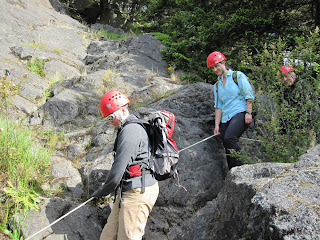In essence the leader who is stationed above the climber is working at a top-managed site. He is belaying the climber from above and is not top-roping. Most people only belay from above after they have lead a climb, but there are a number of situations where it is advantageous to actually top-rope from the top of a climb.
A Climber Belays from the Top
Acadia and Ouray are both popular places where many routes requiretop-managment, climbers literally have little to no choice in many parts of these parks. Acadia is a climbing area situated on a series of sea cliffs. One can only access the crags by lowering down or rappelling down. Ouray is an ice park in Colorado. All of the routes are accessed from the top and most people lower in and then climb back out on a top-rope.
Most places don't require a top-managed set-up like the preceding examples. But there are many advantages to managing a crag from the top.
Value of a Top-Managed Site:
- There is no chance that rocks or other debris will strike a belayer or another climber below. This is particularly nice in ice climbing. In Ouray, it is common for climbers to lower one another into a canyon to climb back out. There are very few people at the base that might be hit by falling ice.
- There is fifty percent less rope in the system. Less rope in the system allows for less elongation in a dynamic rope when a climber falls on a top-rope. This is a great advantage if there are a lot of ledges on a climb that someone might twist their ankle on if they take a short dynamic fall.
- If a climb is over a half of a rope length, it is often easier to manage the route from the top than to deal with two ropes tied together.
- This provides you with the ability to easily monitor the anchor system.
- Smaller loads are placed on the anchor than in a traditional top-rope set-up. In a traditional set-up, the physics of the system make it so that both the climber and the belayer's weight are on the anchor whenever a climber falls or is lowered.
- Occasionally, the bottom of the crag is dangerous. Perhaps you are working on sea cliffs or in another medium that makes the base of the climb hazardous. Numerous crags have parking lots above the routes. In many scenarios the bottom of the climbs are steep and vegetated. In some cases, they are simply hard to access via a trail.
- If you know any quick hauling systems, it's nice to manage from the top because you can assist a person if they get stuck climbing.
- If you want to get a lot of top-rope routes in without leading, it may be fastest to top-manage the climbing area.
A Climber Lowers his Partner from a Top-Managed Site
Disadvantages to a Top-Managed Site:
- It is difficult to see and to coach the climber that has been lowered down. Sometimes it is also difficult to hear.
- The climber's rope is more likely to go over edges when managed from the top.
- There may be more impact on a fragile cliff-top ecosystem.
- If there are many climbers waiting to climb, it may be more dangerous to manage the route from the top. There is more exposure and more opportunities to make a mistake near a cliff-edge.
- People are unused to it and often don't want to try something new.The most common way to access climbs in a top-managed situation is for the climber to lower down and then climb back up. Occasionally, a climber will rappel to the bottom and then climb back up, but this is not quite as safe as lowering. Lowering is safer because the belayer can check the climber's knot before he leaves.
--Jason D. Martin


.jpg)








